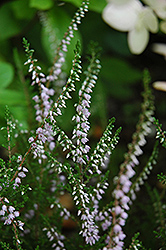It's all about ...
plants

Plant Height: 12 inches
Flower Height: 18 inches
Spread: 24 inches
Sunlight:
![]()
Hardiness Zone: 5a
Other Names: Scotch Heather, Ling Heather
Description:
A taller cultivar with salmon-pink foliage in spring changing to cream, red and bronze as it ages, soft mauve flowers in late summer; very particular about growing conditions, needs acidic organic soil, will die in anything else
Ornamental Features
Arina Heather features tiny spikes of lilac purple bell-shaped flowers at the ends of the branches from mid summer to mid fall. It has attractive emerald green evergreen foliage which emerges salmon in spring. The needles are highly ornamental and turn coppery-bronze in the fall, which persists throughout the winter.
Landscape Attributes
Arina Heather is a multi-stemmed evergreen shrub with an upright spreading habit of growth. It lends an extremely fine and delicate texture to the landscape composition which should be used to full effect.
This is a relatively low maintenance shrub, and should not require much pruning, except when necessary, such as to remove dieback. It is a good choice for attracting bees to your yard. It has no significant negative characteristics.
Arina Heather is recommended for the following landscape applications;
- Mass Planting
- General Garden Use
- Groundcover
Planting & Growing
Arina Heather will grow to be about 12 inches tall at maturity extending to 18 inches tall with the flowers, with a spread of 24 inches. It tends to fill out right to the ground and therefore doesn't necessarily require facer plants in front. It grows at a slow rate, and under ideal conditions can be expected to live for approximately 20 years.
This shrub should only be grown in full sunlight. It requires an evenly moist well-drained soil for optimal growth, but will die in standing water. It is very fussy about its soil conditions and must have sandy, acidic soils to ensure success, and is subject to chlorosis (yellowing) of the foliage in alkaline soils. It is somewhat tolerant of urban pollution, and will benefit from being planted in a relatively sheltered location. Consider applying a thick mulch around the root zone in winter to protect it in exposed locations or colder microclimates. This is a selected variety of a species not originally from North America.
This plant is not reliably hardy in our region, and certain restrictions may apply; contact the store for more information.
